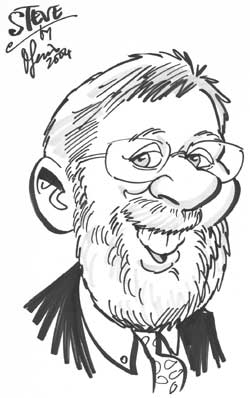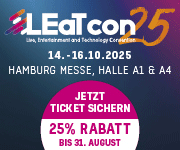profiles - a light-hearted look at industry personalities
No. 98 in a continuing series

Caricatures by

Steve Terry
Vice President of Research and Development, ETC
Throughout his 33-year career in the lighting industry, the word ‘they' has loomed large for Steve Terry. ‘They' might have been a competitor trying to get the next project, or a standards organisation looking to change the rules and make life commercially miserable for the industry. Steve says: "For almost my entire 24 years at Production Arts, I woke up every morning, stood in the shower and thought, ‘How is our competition going to hammer us today, and what we are we going to do about it?'" Likewise, in 1980, the word went out that ‘they' were going to change the US National Electrical Code and make only one type of multi-core cable legal - the kind that Production Arts didn't own - of course.
Steve quickly discovered that most standards and codes are driven by base commercial interests pulling and tugging at safety and practicality. Many people have viewed his standards involvement as an altruistic or academic effort. Nothing could be further from the truth. Commercial paranoia has been the driving force. "Set rational standards that you can work with," Steve advises, "before somebody else does it for you and you can't live with them."
That was the case when Steve took on the issue of interoperability of lighting equipment in 1986. The New York rental houses, Steve's Production Arts among them, were spending huge amounts of time and money getting different manufacturers' equipment to talk to each other. Steve and others drove the issue to the forefront and created the DMX512 standard. "I spent about a year of my spare time (okay, mostly all my time) convincing the industry that interoperability was a good thing. My PA partner John McGraw must have been secretly horrified at the time expenditure." Steve's prodding of the industry led to the adoption of DMX512 for many devices other than its originally-intended dimmers and consoles - and the rest is commercial history. As ETC CEO Fred Foster is fond of saying: "That was your 15 minutes of fame, Terry. Now get over it!"
During the Production Arts years, another interesting thing began to occur. Users and manufacturers (‘theys') began asking, ‘What does Steve Terry think about this problem or product?' Personally, Steve hates the moniker ‘Dimming Guru', but that's what seemed to evolve. "I think people figured out that they could get an honest answer from Production Arts, whether or not we were the right solution provider for their particular problem. That kept them coming back, especially if the suggestion worked," says Steve.
Another aspect of unasked-for guruhood was the large number of articles that Steve has authored in the trade press, ranging from product reviews to electrical code issues to control protocols. Steve was among the group that pressed the Theatrical Dealers Association to transform itself into the Entertainment Services and Technology Association - ESTA - and develop a standards programme to produce the next advanced control protocol. ANSI E1.17, commonly known as ACN, will be that project come to fruition. "When ESTA made their name change and hired a full-time standards manager, that's when standards in the entertainment industry stopped being a hobby. And that made me very happy," says Steve.
After three years at PRG, which purchased Production Arts in 1998, Steve moved on to ETC, where he is now Vice President of Research and Development. "Now I've only got myself to yell at about product issues," says Steve, "I hope it's not karmic revenge!"
Steve, who is based in New York City, spends two weeks a month at the ETC headquarters in Middleton, Wisconsin. A self-described food snob and motorcycle junkie, Steve wasted no time in making his Middleton apartment into a home. There's a BMW K1100 RS bike in the garage (one of seven BMW's he owns - the oldest being a 1928), homemade beef stock in the freezer, and a hefty Cuisinart on the kitchen counter.
This nomadic life is nothing new for Steve. In his early career, he toured the world for over five years as head electrician for the Dance Theatre of Harlem, which gave him an end-user's eye view of lighting when he started designing gear for Production Arts' rental inventory years later. Steve also has the white-knuckled distinction of having been responsible for the care and feeding of the first computer lighting control system on Broadway - the LS-8 on A Chorus Line, in the 70's. Drawn to Broadway by its memorable dancers and actresses, Steve eventually married one (but that's another story). He also served as sound engineer on A Chorus Line and other Broadway shows, where he learned his limitations and went back to lighting. It turns out that when putting on a show, everybody in the theatre has two jobs: their own - and sound.
The relative impartiality that Steve once enjoyed when throwing darts at manufacturers from a distance or answering industry questions is necessarily different now. "My professional home is at ETC, a fact that my consultant friends are quick to remind me of," says Steve. "My favourite example of that particular learning curve is a short article I wrote in 2001 entitled ‘Why I still like SCR Dimmers'. It was full of pretty reasonable commentary, primarily driven by the fact that ETC's concentration was on SCR dimmers at that time. To my extreme chagrin, in a recent ESTA brainstorming session about future articles for their journal Protocol, my ex-PA colleague Mike Lay, now at Strand, submitted an article request. He quipped: "Let's see an article called ‘Why I Now Like Sine Wave Dimmers' - by Steve Terry." Touché!
Look out for the next subject in our Profile series...
view other profiles
© 1999 - 2025 Entertainment Technology Press Limited News Stories







